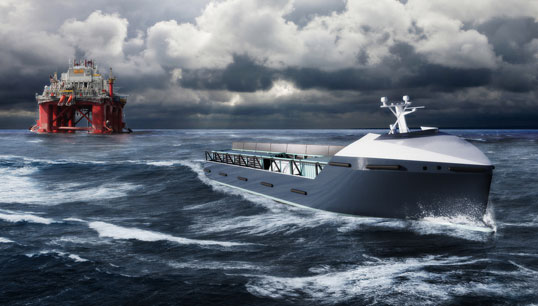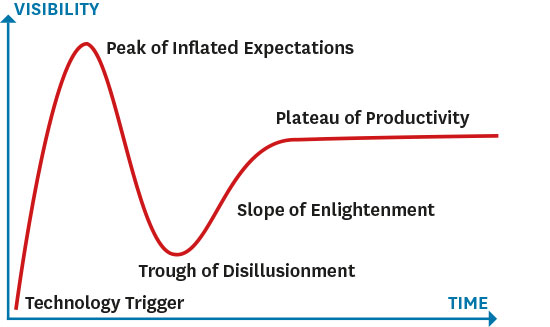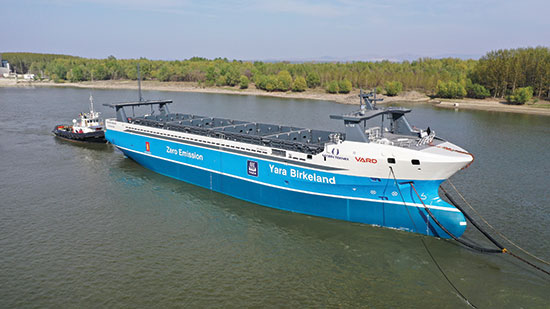- Topics
- Campaigning
- Careers
- Colleges
- Community
- Education and training
- Environment
- Equality
- Federation
- General secretary message
- Government
- Health and safety
- History
- Industrial
- International
- Law
- Members at work
- Nautilus news
- Nautilus partnerships
- Netherlands
- Open days
- Opinion
- Organising
- Switzerland
- Technology
- Ukraine
- United Kingdom
- Welfare

Automation has been a major talking point in shipping over the last few years, with designers dreaming of cost-effective crewless vessels transporting cargo across the oceans, and seafarers wondering if they should train in remote control operation in order to keep their jobs. But what has been happening in practice? David Appleton investigates
When businesses are assessing the value of a new technology, they often use a tool called the Gartner Hype Cycle, which is a graphical representation of the perceived value of a technology over time as expectations and hype play out against actual adoption and performance.

Typically, a technological breakthrough causes a phase of considerable media attention and activity from early adopters which culminates in the 'peak of inflated expectations'. As interest wanes and the technology fails to gain market traction, the peak of excitement is followed by the 'trough of disillusionment'.
Once the benefits of the technology become more widely understood, more companies are willing to invest and we embark up the 'slope of enlightenment' towards the final destination: the 'plateau of productivity' and widespread adoption.
Shipping's peak of inflated expectations
If we look back at the period of 2016/2017 – where all manner of grand pronouncements were being made regarding the imminent arrival of fully autonomous ships and the subsequent demise of the traditional seafarer – it would not be unfair to mark this point as the 'peak of inflated expectations' in our industry.
The big players in the field had set out ambitious timelines for their anticipated adoption of marine autonomous surface ships (MASS). Rolls Royce had boldly stated that it expected to see remote controlled vessels in commercial use by the end of the decade, ocean-going by 2025 and widespread adoption by 2030. Norwegian companies Yara and Kongsberg announced in 2017 that they would build the world's first fully electric and autonomous container ship, Yara Birkeland, which was slated to begin manned operations in 2018 before transitioning to remote control by 2019 and fully autonomous operation by 2020.

Fast forward to 2021, and so far, none of these predictions have come true. Notwithstanding the 5kg of oysters that was delivered to Belgium from Mersea Island in Essex in 2019, there are not yet any commercially-operated autonomous vessels in operation. Advocates will claim that there are 'thousands' of autonomous vessels currently in operation, but what they are actually referring to are very small vessels, generally operating from a mothership and carrying out specific activities such as surveying which would not be financially viable on a crewed vessel.
Meanwhile, it has been announced that although the Yara Birkeland was delivered to its owners somewhat behind schedule in November last year, it will not be operating autonomously for the foreseeable future due to difficulties with the autonomous logistics on land.
Regulatory developments
Although the progress of commercial projects has been slow, the industry has welcomed the news that the IMO Maritime Safety Committee (MSC) completed the first step of its Regulatory Scoping Exercise (RSE) at its 103rd session held from 5-14 May 2021.
Work on the RSE was initiated in June 2017 after a proposal from a coalition of flag states which included the United Kingdom and the Netherlands suggesting that there was an urgent need to clarify how IMO instruments could be effectively applied to MASS. It was argued that this action was necessary in order to prevent a proliferation of conflicting national regulations or the development of MASS in an unregulated manner should the IMO fail to act.
The exercise was finalised by a working group of interested flag states and observer organisations at MSC 103. It involved assessing a substantial number of IMO instruments under the remit of the MSC and identifying provisions which either apply to MASS and prevent MASS operations, do not apply to MASS and do not prevent MASS operations, or; apply to MASS but need some amendment or clarification.
What do we really mean by 'autonomous'?
When deciding how an instrument would be applied to MASS, four degrees of autonomy were considered. Degree one was considered to be a conventionally crewed ship with automated processes and decision support, degree two was a remotely controlled ship with seafarers onboard, degree three, a remotely controlled ship with no seafarers onboard and degree four, a fully autonomous ship.

Whilst the IMO is hailing the completion of this exercise as an important first step to ensure that regulation will keep pace with technological developments, a closer inspection of the report and the papers considered during the working group's discussion illustrates the difficulties involved in attempting to regulate for a technology that does not yet exist.
The fact that definitions are yet to be mutually agreed for basic terms such as 'automatic' and 'autonomous' after four years of deliberations will come as a surprise to many. Indeed, the revelation that the volunteering flag states had significantly differing understandings of what they should presume when carrying out their analysis – and that some think the concept of the four degrees of autonomy was flawed from the outset – calls into question the long-term value of the 115-page document. Many are now arguing that regulations should look at onboard functions and systems rather than the autonomy level of the ship as a whole.
Granted, the committee did note that the best way forward to regulate MASS in the future was likely to be a stand-alone 'MASS Code'. However, this should have been obvious from the outset, considering that the alternative was to amend every single IMO instrument individually to ensure that it applied to both conventional ships and MASS. The fact is that all of the most difficult questions have been left for another day.
The steep climb ahead
The list of high-priority outstanding issues that have been identified include: the definition of the role of the shipmaster and how the various responsibilities and obligations placed upon the master could be applied to MASS; the functional and operational requirements of any remote-control centre; and whether or not a remote operator should be considered a seafarer, which will determine if their training requirements are determined by STCW or not.
This is in addition to matters that will need to be resolved elsewhere, including whether or not an uncrewed ship would be compliant with the United Nations Convention on Law of the Sea (UNCLOS), which requires every ship to be under the control of a suitably qualified master and officers, and the question of who would be liable in the event of an accident (particularly pertinent as there would be no crew to pin the blame on).
Manufacturers remain bullish about the prospects for autonomous shipping and are predicting that the market will grow to $9.24 billion in 2025 – up from $5.68 billion in 2020. However, even if they manage to overcome the significant legal and practical challenges, they may find that they have an even bigger mountain to climb convincing traditionally cautious shipowners of the business case.
We should remember that timelines will have inevitably slipped due to the pandemic, but looking forward to 2025 (the year we were promised the first commercially operated ocean-going vessel), we should by then be able to tell just how much was hype and what was based on reality.
Industry working group to tackle autonomy training needs
While the regulatory work on automation slowly progresses at the International Maritime Organization, a working group has been set up in the UK by industry stakeholders to press ahead with the development of training standards.
The Apprenticeship Trailblazer Group in Autonomous and Remote Vessel Operations came into being through a partnership between the Royal Navy and maritime training agency SeaBot XR. Numerous maritime employers are also involved, including geo-data specialist Fugro, the UK National Oceanography Centre and marine robotics company Ocean Infinity.
The aim of the group is to identify the necessary skills and competencies for the emerging maritime autonomous surface ship (MASS) sector and develop an apprenticeship route to prepare trainees for the jobs of the near future.
In a statement about the venture, SeaBot XR said: 'The autonomous vessel movement was gaining traction prior to the Covid-19 pandemic and has been further spurred on since. Autonomous and remotely operated vessels will sail with few or no crew onboard, but their introduction will not reduce the requirement for highly trained personnel. It will, however, dramatically alter the necessary competencies needed to monitor and control such vessels.'
Initially, the group will identify the basic skills and competencies an individual will require to safely navigate, control and manage small- to medium-sized MASS vessels. It will analyse emerging requirements and define various occupational and training standards. As the industry matures, the group intends to blend this training, building upon basic skills, with the more advanced knowledge of routes and specialisms that will be required for the operation of MASS vessels.
RN Commodore Andy Cree commented: 'The Royal Navy, through its lead of the Solent Maritime Enterprise Zone, has a sharp focus on identifying and addressing the future skills gaps associated with new and emergent maritime technologies.
'We are therefore delighted to be part of this Apprenticeship Trailblazer Group, developing employer-led apprenticeship standards in autonomous and remote vessel operations which will pave the way for a skilled maritime workforce of the future.'
SeaBot XR CEO Gordon Meadow added: 'We hope that the work carried out by the group could eventually form a blueprint for maritime regulation and government legislation.'
Tags
